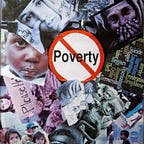Who Created Poverty and How Does it Grow?
Poverty is a human-made phenomenon. Just as humans have created great wealth, we have created great poverty. The causes of poverty in every country are deeply rooted in the global system, which has been programmed over thousands of years to benefit the richest and most powerful — from colonialism, to structural readjustment and the global spread of neoliberalism today.
Although the causes are complex, the fact that they are programmed into the system by humans gives us hope. It means they are solvable and changeable — it means we can work to reprogramme the system to prioritise people rather than profit. This is why we campaign for policy change, as well as working with communities and governments around the world to improve health and tackle injustice together.
In far too many cases, the causes of poverty are brushed over and ignored. We are often encouraged to take pity on those ‘unlucky’ enough to be in poverty, and give money because we are the ‘lucky ones’.
Very rarely are we encouraged to think about how we might be impacted by the same system which causes this extreme poverty — how we unjustly benefit from it, or how we are also suffering because of it.
Without understanding the root causes of poverty, it will be impossible to prevent it from happening in the future.
To learn more about the causes of poverty check out my other blogs at: https://project-change-our-mindsets.medium.com/
The authors first review some basic facts about the nature of poverty in the United States: according to the March Current Population Surveys, poverty rates are generally higher among children than among adults. In 2003, children were approximately 29 percent of the non-elderly population but they constituted 40 percent of the non-elderly poor; 17.6 percent of all children lived in households with incomes below the poverty line. Overall, only 7 percent of those living in households headed by a married individual were poor, whereas households with an unmarried head and children present — 83 percent of which were headed by women — had poverty rates of 40.3 percent. Likewise, the probability of being poor varies tremendously by race: blacks and Hispanics are much more likely to be poor than whites, even though most of the poor are white.
The persistence of poverty also depends strongly on individual and family characteristics. Among those beginning a spell of poverty, about 83 percent of white children living in two-parent households headed by someone with at least a high school education will escape long-term poverty. In contrast, only 10 percent of poor black children in a household headed by a single woman without a high school diploma will avoid it.
Specifically, they find that the unemployment rate, median wages, and wage inequality in the lower half of the wage distribution all are significant determinants of poverty rates. Overall, increasing the unemployment rate by 1 percentage point increases the poverty rate by 0.4 to 0.7 percentage points. Increasing the median wage by 10 percent decreases the poverty rate by about 2 percentage points. Increasing the ratio of the median wage to the average weekly wage in the 20 percentile of the wage distribution (a measure of inequality) by 10 percent increases the poverty rate by roughly 2.5 percentage points.
Poverty is an issue, and long-term data has proven that poverty rates have reduced. The world has to work harder to completely eliminate extreme poverty.
Resources
How Poverty Is Created | Health Poverty Action. (2021). Healthpovertyaction.org. https://www.healthpovertyaction.org/how-poverty-is-created/
Why Poverty Persists. (2020). NBER. https://www.nber.org/digest/jun06/why-poverty-persists
